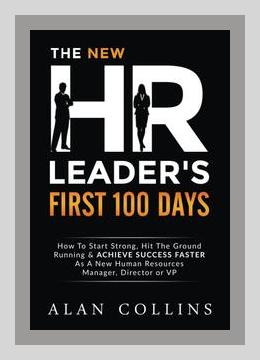Human Resources and Talent ManagementHR Technology
Introduction
Alan Collins’ book “The New HR Leader’s First 100 Days” aims to guide freshly appointed HR managers, directors, and VPs in strategically navigating their inaugural phase. The author leverages his extensive experience to offer practical insights and actionable advice to help HR leaders make a lasting impact. This summary distills the book’s key points along with concrete examples and recommended actions.
1. Preparing for the Role
-
Understanding Organizational Culture
Action: Conduct a pre-arrival assessment.
During the interview and onboarding process, gather as much information as possible about the company culture. Seek out insights from LinkedIn, Glassdoor, and other sources.
Example: An incoming HR Director might reach out to a predecessor or trusted confidants within the organization to understand the informal power structures and prevailing cultural norms. -
Building Personal Credibility
Action: Develop a credibility plan.
Establish a strong first impression by preparing thoroughly for meetings, communicating consistently, and demonstrating industry knowledge.
Example: A new HR manager could start by delivering a well-researched presentation during their first team meeting.
2. First 30 Days: Observation and Assessment
-
Listening Tours
Action: Schedule one-on-one meetings.
Meet individually with key stakeholders, including direct reports, peers, and senior leadership.
Example: For an HR VP, these meetings might include discussions with CFOs and COOs to understand their expectations and pain points. -
SWOT Analysis
Action: Conduct a SWOT workshop.
Evaluate the department’s strengths, weaknesses, opportunities, and threats, involving the team in this process to gain varied perspectives.
Example: An HR director might convene a departmental meeting to gather input and identify areas for quick wins and long-term improvements. -
Quick Wins
Action: Implement small, impactful changes.
Demonstrate the ability to drive results by addressing low-hanging fruit.
Example: Rolling out a quick employee satisfaction survey to gather actionable feedback can illustrate commitment to improvement.
3. Days 31-60: Strategy Development
-
Crafting a Vision
Action: Develop a clear HR vision statement.
Create a vision aligned with the company’s broader goals and communicate it across the team.
Example: An HR manager might articulate a vision aimed at transforming the talent acquisition process to attract higher-caliber candidates. -
Setting Strategic Objectives
Action: Establish SMART goals.
Define Specific, Measurable, Achievable, Relevant, and Time-bound objectives to track progress and stay focused.
Example: A strategic goal could be to reduce employee turnover by 15% within the next year through targeted retention programs. -
Aligning With Business Goals
Action: Formulate alignment plans.
Ensure HR initiatives support overarching business objectives by collaborating closely with executive leadership.
Example: An HR VP might work with the finance department to integrate workforce planning into the yearly budgeting process.
4. Days 61-90: Implementation and Adjustment
-
Building a High-Performance Team
Action: Assess and develop your team.
Identify skills gaps and provide opportunities for professional development and growth.
Example: Introducing mentorship programs or specialized training sessions tailored to emerging areas like HR analytics. -
Driving Change
Action: Develop change management strategies.
Utilize structured change management methodologies to facilitate transitions and mitigate resistance.
Example: Implementing a new HRIS system may require a well-thought-out communication plan to ensure smooth adoption. -
Metrics and KPIs
Action: Define and monitor KPIs.
Establish key performance indicators aligned with strategic objectives to measure progress and impact.
Example: KPIs could include time-to-fill metrics for recruitment, employee engagement scores, and training completion rates.
5. Day 91-100: Consolidation and Reflection
-
Review and Reflect
Action: Conduct a 100-day review.
Revisit the achievements and gaps from the initial 100 days, and solicit feedback from stakeholders to understand areas of improvement.
Example: Setting up a feedback session with the C-suite to evaluate the first 100 days and outline priorities for the next phase. -
Future Planning
Action: Develop long-term plans.
Based on the insights gained, refine strategies and develop plans for the next quarter and beyond.
Example: Drafting a long-term HR roadmap that includes initiatives such as leadership development, diversity, and inclusion programs.
Concrete Examples from the Book
- Pre-Arrival Preparation: An HR leader joining a tech company might find out about its innovation-focused culture and prepare to introduce agile HR practices.
- First 30 Days Listening Tours: An HR manager in a manufacturing firm could meet with plant supervisors and frontline employees to understand their on-the-ground challenges.
- Implementing Quick Wins: A new HR director noticing outdated recruitment processes might quickly implement an applicant tracking system (ATS) to streamline hiring.
- Setting Strategic Goals: An HR VP might set a goal to boost internal promotions by 10% within six months by designing and implementing a robust internal mobility program.
- Driving Change: Rolling out a new performance management system might involve detailed training sessions, town halls, and continuous support to ensure buy-in and ease the transition.
Specific Actions Summarized
- Pre-Arrival
- Conduct organizational culture research.
- Develop a personal credibility plan.
- First 30 Days
- Schedule one-on-one meetings for listening tours.
- Conduct a SWOT analysis workshop.
- Identify and implement quick wins.
- Days 31-60
- Develop and articulate a clear HR vision.
- Set SMART strategic objectives.
- Formulate plans to align with business goals.
- Days 61-90
- Assess and focus on team development.
- Create structured change management strategies.
- Define and monitor relevant KPIs.
- Day 91-100
- Conduct a comprehensive review of the first 100 days.
- Develop and refine long-term strategic plans.
Conclusion
Alan Collins’ “The New HR Leader’s First 100 Days” is a comprehensive guide providing HR leaders with essential tools to navigate their critical early days effectively. By understanding the organizational culture, conducting thorough assessments, setting strategic goals, and implementing change cohesively, new HR managers, directors, and VPs can pave the way for long-term success. Utilizing concrete examples and implementing specific actions as outlined can help ensure they start strong and achieve impactful results swiftly.
